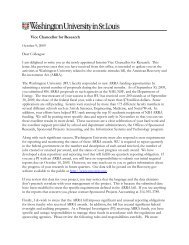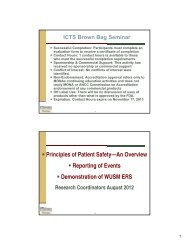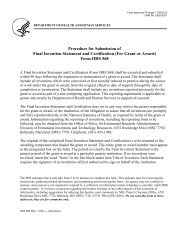A Letter from The Office of the Vice Chancellor for Research
A Letter from The Office of the Vice Chancellor for Research
A Letter from The Office of the Vice Chancellor for Research
Create successful ePaper yourself
Turn your PDF publications into a flip-book with our unique Google optimized e-Paper software.
OVCR Annual ReportFiscal Year 2011Technology Management & Intellectual PropertyNovel Genetic Risk Factor <strong>for</strong> Alzheimer’s Disease Progression<strong>Research</strong>ers at Washington University have identified a novel genetic variant that stronglycorrelates with Alzheimer’s disease progression. Dr. Alison Goate and collaborators used anestablished biomarker <strong>for</strong> <strong>the</strong> decline <strong>of</strong> AD patients (cerebrospinal fluid tau phosphorylated atthreonine 181, ptau 181 ) to find genetic variants that influence levels <strong>of</strong> ptau 181 in <strong>the</strong> cerebrospinalfluid. <strong>The</strong> study found a highly significant association between ptau 181 levels and <strong>the</strong> rs1868402SNP located within a regulatory subunit <strong>of</strong> PPP3R1 (calcineurin B), a gene previously linked toAD pathogenesis. Carriers <strong>of</strong> <strong>the</strong> rs1868402 risk allele showed a 6-fold faster rate <strong>of</strong> diseaseprogression than AD patients without <strong>the</strong> variant. Direct examination <strong>of</strong> brain samples <strong>from</strong>AD cases and controls revealed that rs1868402is in fact associated with reduced PPP3R1 mRNAlevels and increased tangle <strong>for</strong>mation, providing biological validation <strong>for</strong> <strong>the</strong> genome-wideassociation study and fur<strong>the</strong>r implicating PPP3R1 in disease pathology. As <strong>the</strong> first geneticvariant associated with rate <strong>of</strong> AD progression to be reported, its use in clinical trial design andpatient care will translate into a significant benefit to patients. Primary Investigator: AlisonGoate, PsychiatryBlood A production and Clearance Measurements as a Diagnostic Test <strong>for</strong>Amyloidosis and Alzheimer's DiseasePrevious work <strong>from</strong> <strong>the</strong> Bateman and Holtzman labs have demonstrated clinical utility inmeasuring <strong>the</strong> syn<strong>the</strong>sis and clearance rates <strong>of</strong> <strong>the</strong> amyloid-beta (Aβ) protein as a biomarker <strong>for</strong>efficacy <strong>of</strong> candidate Alzheimer’s drugs that target <strong>the</strong> protein. In a completely distinctinvention, <strong>the</strong> labs have demonstrated <strong>the</strong> ability to detect changes in Aβ in blood plasma, anassay that has utility <strong>for</strong> assessing drug candidates as well as diagnostic applications. PrimaryInvestigator: Randy Bateman, Neurology, and Dave Holtzman, NeurologyNovel Antithrombin Nanoceutical <strong>for</strong> Preventing Blood Clots<strong>The</strong> current invention comprises a first-in-class nanoparticulate antithrombotic that features apotent dual antithrombin/antiplatelet compound linked to a nanoparticle to function as a singleunit or drug. Advantages <strong>of</strong> this novel agent include (1) prolonged activity <strong>of</strong> drug at <strong>the</strong>nanoparticle surface and only at <strong>the</strong> site <strong>of</strong> active clotting, (2) potential <strong>for</strong> image-baseddetection and tracking <strong>of</strong> <strong>the</strong> agent and <strong>the</strong> acute thrombotic process, (3) <strong>the</strong> elimination <strong>of</strong>harmful side effects after systemic delivery through <strong>the</strong> use <strong>of</strong> smaller drug amounts featuringsite-specific thrombin targeting and action, (4) well defined pharmacokinetics that are driven by<strong>the</strong> nanoparticle itself and are independent <strong>of</strong> a subject’s genetics, and (5) <strong>the</strong> ability to multiplex anyo<strong>the</strong>r anticoagulant that is already on <strong>the</strong> market or in development <strong>for</strong> combination<strong>the</strong>rapeutics. Studies indicate <strong>the</strong> nanoceutical outper<strong>for</strong>ms standard heparin treatment, byincreasing <strong>the</strong> time to total occlusion by more than 40%. Primary Investigator: SamuelWickline, Internal Medicine, Cardiovascular Division.Novel Compounds to Treat Urinary Tract InfectionUrinary tract infections (UTI) affect a large proportion <strong>of</strong> <strong>the</strong> population and account <strong>for</strong>significant morbidity and high medical costs. Uropathogenic Escherichia coli (UPEC) isresponsible <strong>for</strong> up to 85% <strong>of</strong> infections and a large percentage <strong>of</strong> recurrent UTI are caused by<strong>the</strong> same strain <strong>of</strong> bacteria as <strong>the</strong> initial UTI despite <strong>the</strong> antibiotic regimen; <strong>the</strong> current gold49
















